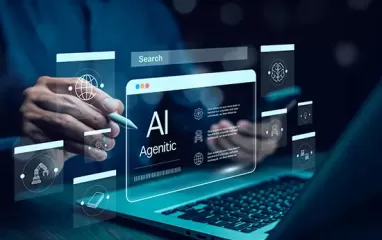Other recent blogs



Let's talk
Reach out, we'd love to hear from you!
Presently, the banking and finance sector is witnessing a seismic transformation, and the major protagonist behind this transformative tide is Generative AI (GenAI). This technology breakthrough has gained widespread popularity in a remarkably short time, and the banking sector is likely to be more profoundly impacted by gen AI than any other industry.
Here's the proof:

When put into sharper focus, the intelligent capabilities of these progressively adaptive LLMs have fundamentally changed banks and the finance sector—be it customer interactions, personalized wealth advisory, or guided commercial relationship conversations. Generative AI in banking empowers CEOs with enhanced capabilities to turn even a modest number of digital interactions into meaningful conversations with customers across digital channels.
Banks operating in an unsettled landscape have now been able to accelerate the execution journey toward GenAI-led digital transformation and redefine all aspects of banking operations. Banks can achieve a competitive advantage by delivering personalized services and boosting operational efficiency. This technology allows banks to make insightful, data-driven decisions, manage risks effectively, and improve customer satisfaction.
GenAI in Banking: Unlocking the potential benefits
By 2030, the banking industry is expected to invest 84.99 billion U.S. dollars in Generative Artificial Intelligence, reflecting a robust compound annual growth rate of 55.55 percent. For banks seeking to tap this valuable technology, GenAI is a stepping stone to transcend the ordinary bounds of automation.
Companies can apply Artificial Intelligence in banking at various settings, from routine and repetitive tasks to knowledge-based and creative work, draw intelligent insights, and solve intricate problems. The path to GenAI-led transformation unlocks many transformational benefits.
Let's explore the top reasons why banks should not underestimate GenAI's full potential:
.webp)
1. Customer Experience:
Generative AI is revolutionizing the way banks interact with their customers by harnessing the power of vast data analysis. It employs intelligent algorithms to sift through enormous datasets and extract valuable insights into customer behaviors, preferences, and needs. By leveraging these insights, bank CEOs can enhance the level of personalization that was previously unattainable in financial services.
The impact of GenAI in financial services and banking is far-reaching and shows no signs of slowing down—transforming everything from investment advice to product recommendations. For instance, AI can analyze a customer's financial history, risk tolerance, and future goals to suggest tailored investment strategies that align perfectly with their individual circumstances. Similarly, when it comes to financial products, the AI can consider a customer's spending patterns, credit history, and life stage to recommend the most suitable credit cards, loans, or savings accounts.
This shift towards hyper-personalization is profoundly affecting banks' sales departments and customer contact centers. Sales teams can now approach customers with offerings that are much more likely to resonate, increasing conversion rates and customer satisfaction. In contact centers, AI-powered systems can provide customer service representatives with real-time, context-aware suggestions, enabling them to offer more relevant and helpful assistance.
By embracing generative AI, banks are not just improving their services; they're redefining the entire customer experience. This technology enables them to move away from a one-size-fits-all approach to a model where each customer interaction is unique and tailored, fostering stronger relationships and loyalty. As this technology continues to evolve, it promises to further blur the lines between digital convenience and personalized human touch in banking services.
2. Risk Assessment and Fraud Detection:
Also known as KYC (Know Your Customer), this is crucial for banks. Generative AI supports operational tasks using machine learning algorithms to analyze transaction patterns and swiftly flag suspicious activities in real-time.
Generative AI helps bank CEOs address critical challenges that traditional methods often struggle with and strengthen security posture with minimal potential risks for customers and the bank.
By harnessing the power of advanced machine learning algorithms, these AI systems can analyze vast amounts of complex transaction data in real-time, identifying subtle patterns and anomalies that might indicate fraudulent activity.
This capability goes far beyond simple rule-based systems, allowing banks to detect sophisticated fraud schemes that would otherwise go unnoticed. The AI's ability to adapt and learn from new data means it can keep pace with evolving fraud tactics, continuously improving its detection capabilities without extensive manual intervention.
Moreover, generative AI in banking excels at predictive analytics, enabling banks to anticipate potential risks and vulnerabilities before they materialize. This proactive approach to risk management can significantly enhance a bank's security posture and protect its customers from financial harm. The technology also shows promise in reducing false positives, a common issue in fraud detection that can lead to customer frustration and operational inefficiencies.
Generative AI helps banks strike a better balance between security and customer experience by providing more accurate and nuanced risk assessments. These AI systems can also process and analyze unstructured data from various sources, including customer communications and social media, providing a more comprehensive view of potential risks. This holistic approach to risk assessment and fraud detection strengthens a bank's security measures and supports more informed decision-making across various banking operations.
3. Compliance and Regulatory Policies:
Regulatory compliance is a critical imperative in the banking sector. Generative AI enhances banks' ability to meet complex and evolving regulatory requirements by constantly tracking changes in legislation and promptly adjusting internal procedures to maintain compliance. This proactive approach significantly mitigates the risks of regulatory breaches and associated penalties.
In the realm of anti-money laundering (AML), generative AI plays a crucial role in strengthening banks' defenses against illicit financial activities. These AI systems can analyze vast amounts of transaction data, customer information, and external sources to identify suspicious patterns that may indicate money laundering attempts. By employing advanced machine learning algorithms, AI can detect complex money laundering schemes that might elude traditional rule-based systems.
AI in banking enhances AML efforts through several key capabilities:
- Transaction monitoring: AI systems can analyze transactions in real-time, flagging those that exhibit characteristics associated with money laundering, such as unusual patterns, frequencies, or amounts.
- Customer risk profiling: By analyzing diverse data points, AI can create more accurate and dynamic risk profiles for customers, helping banks apply appropriate due diligence measures.
- Network analysis: AI can map and analyze complex networks of transactions and relationships between entities, uncovering potential money laundering rings or shell company structures.
- Adaptive learning: As new money laundering techniques emerge, AI systems can quickly adapt their detection methods, staying ahead of evolving criminal strategies.
- False positive reduction: Advanced AI models can more accurately distinguish between legitimate and suspicious activities, reducing the number of false alarms that can overwhelm compliance teams.
- Automated reporting: AI can assist in generating and filing suspicious activity reports (SARs) more efficiently, ensuring timely compliance with reporting requirements.
By leveraging these capabilities, generative AI significantly enhances banks' AML efforts, improving their ability to detect, prevent, and report potential money laundering activities. This not only helps banks maintain regulatory compliance but also plays a crucial role in combating financial crime on a global scale.
4. Automated Document Processing:
Banks can capture new relevant information and convert it using generative AI, making what has been a lengthy process more efficient and accurate. There are also several ways of using such technologies in the field: Modern AI-powered systems can quickly and efficiently analyze various financial documents, including loan applications, balance sheets, and even complex financial statements, with a high level of detail and precision in terms of extracting valuable information.
This automation enhances efficiency since it shortens the time needed to process such information, diminishes the likelihood of errors, and frees banking staff to perform more complex tasks. This, combined with the other outcomes mentioned above, increases productivity and efficiency within different business processes, leading to the integration of shorter time required for approvals and all the other matters that heavily rely on documents.
5. Personalized Financial Products:
Breakthroughs like Generative AI in banking can make conclusive estimations based on the mass amounts of data that customers expend or invest in and their major life occurrences and determine the specific financial services that will efficiently correspond with the individual’s requirements. It also encompasses introducing a flexible pricing scheme depending on the client and the market situation or creating an individual approach to investment management and portfolio services.
All in all, the above personalization not only enhances the customer’s perceived service quality but can also enhance the likelihood of customer acceptance of the product and subsequent customer loyalty.
This is just the tip of the iceberg regarding how Generative AI can help banks become more innovative, achieve better operational efficiency, and stay competitive.
A common question from our clients at Kellton is how to get strategic value out of Generative AI. Well, our typical advice is to start the Generative AI journey with well-defined use cases and use a human-centric approach to create these use cases, focusing on driving value.
In the financial market, most use cases are created for operational excellence, such as virtual assistants or chatbots, fraud detection, and regulatory compliance. For business growth, use cases of generative AI in financial services are mainly for mortgage management and social listening.
To help clients prioritize these cases, we use diagram grouping, which divides them into different categories: quick wins, strategic, tactical, and low priority. Such an approach creates a more efficient view of use cases and better value from the Generative AI journey. Once the use case is defined and prioritized, it must be transformed into a productive solution.
How Kellton unlocks the future opportunities?
Generative AI is undergoing rapid advancements, showing immense potential to transform business operations in the banking industry and create a unique value proposition for the financial sector, which aims to maintain or increase its market share. Integrating advanced Artificial Intelligence and banking together into existing applications and workflows is advisable. However, examining the benefits and potential risks is equally important.
Successful implementation requires considering several factors, such as workflow integration, employee training, data quality, customization, fine-tuning, continuous monitoring, and evaluation. Ethics, privacy, and security measures must be closely considered.
Transform your banking business with the latest Generative AI technology. Kellton, as a strategic digital transformation partner, helps CEOs in the banking and finance industry capitalize maximum on the major benefits of Generative AI use cases by designing a methodology and a cognitive framework. We focus on custom generative AI solutions that can bring your bank into the future of finance and help businesses start the journey toward AI success.
We revolutionize your banking operations with cutting-edge generative AI solutions and drive innovation along with enhanced customer experiences and streamlined business processes. Transform the future of AI in banking with us now.



